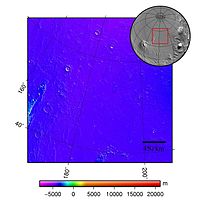 Topographic map of Arcadia Planitia | |
| Feature type | Plains |
|---|---|
| Coordinates | 47°12′N 184°18′E / 47.2°N 184.3°E |
Arcadia Planitia is a smooth plain with fresh lava flows and Amazonian volcanic flows on Mars. It was named by Giovanni Schiaparelli in 1882 after the Arcadia region of ancient Greece. It dates from the Amazonian period's Arcadia formation's lava flows and small cinder cones. It includes a more recently developed large region of aeolian materials derived from periglacial processes.
It is located northwest of the Tharsis region in the northern lowlands, spanning roughly the region 33.9–64.2° North and 165.9–210.4° East, straddling partly in the Cebrenia quadrangle (MC-07), and partly in the Diacria one (MC-02), and centered at 47°12′N 184°18′E / 47.2°N 184.3°E.[1] Arcadia marks a transition from the thinly cratered terrain to its north and the very old cratered terrain to the south. On its east it runs into the Alba Mons volcanoes. Its elevation relative to the geodetic datum varies between 0 and -3 km.[2]
Many low-lying areas of Arcadia are marked by grooves and sub-parallel ridges. These features indicate glaciation and appear similar to those on Earth, where the freezing and thawing of water located between ground layers contributes to the slow flow of near-surface materials. This supports the proposition that ground ice exists in the near-surface of Arcadia Planitia, and therefore this location is an area of interest for potential exploration missions.[3]
- ^ "Arcadia Planitia". Gazetteer of Planetary Nomenclature. USGS Astrogeology Science Center. Retrieved 10 March 2015.
- ^ R. Greeley, "Arcadia Planitia" Archived March 11, 2007, at the Wayback Machine URL accessed July 31, 2006.
- ^ Hibbard, Shannon M.; Williams, Nathan R.; Golombek, Matthew P.; Osinski, Gordon R.; Godin, Etienne (1 May 2021). "Evidence for widespread glaciation in Arcadia Planitia, Mars". Icarus. 359: 114298. doi:10.1016/j.icarus.2020.114298. ISSN 0019-1035. S2CID 234181075.